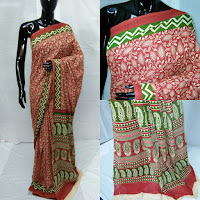In the Indian culture, Saree is considered as a valuable outfit for women. Many women also wear this Saree as their daily costumes, even at home. They feel very comfortable while wearing that saree and saree also let the woman look very elegant. They are the main costumes for every Indian woman, and even teenage girls love to wear them on different occasions. Women love to shop them from best Cotton sarees suppliers. They are made of different fabrics and endless prints. Among them, cotton Saree is the most comfortable and popular. They are perfect for women who love to maintain them selves simple but fashionable. The Saree is the only one outfit that can be worn in different ways. In today's changing fashion world, designer Cotton Sarees is also gaining wide popularity on the international market and online buying is now a smarter way to collect at your doorstep.
Know the best specialty of Cotton Saree :
- Cotton sarees are generally very light weighted and comfortable to carry.
- Cotton sarees are very soft and they even don't irritate the skin.
- Cotton sarees comes in very vibrant color, some floral prints and these are available at an affordable price.
- Nowadays, sarees are also in trend both as traditional and fashionable wear.
Now Sarees are in trend among all age of women and girls and its best part is that it comes in a variety of prints which suits to all age of women. Today's the desire for cotton has increased and the good news is that we can afford them at a reasonable price, with the help of best cotton production of new technology machines.
Know about cotton sarees trendy design and style :
As the days changed quickly, the use and selection of Sarees Embroidery also changed. Today, the embroidery design saree either they are handmade or machine made is in demand. Most embroidery is made of gold thread, silver thread or cord. But we can combine them together and can also use the lines of Zardozi to make them more trendy for the contemporary ladies who love to wear ethnic. The most popular style which is in trend is the design of heavy embroidery in the base of pallu and on the base of saree too. Another fashionable and trendy work on cotton is netted and heavy cotton work, as well as light embroidery. There are a lot of suppliers who offer you a variety of newly designed Sarees for parties, wedding ceremonies or according to daily necessities. All products are comfortable, skin friendly, light weight, and fashionable.
These days, you can find a variety of designs in these Sarees for casual wear, as well as for all parties. From embroidered borders to simple borders, you can find all the design on the online shopping site. So buy online and browse the latest varieties, from a number of well-known brands like Aadrika, Admyrin, Vibhaa, Swaraaa, Florence, Laxmi, Chhabra 555 and Banarasi Style and other designers.
You can go for some of the prettiest cotton sarees like,
- Plain white saree having golden border : White cotton Saree is the most elegant and classic among womens. They are designed with gold borders. These gorgeous Sarees are absolutely necessary for every wardrobe. Make sure you have the best in your collection. They also have other popular colors such as black, red and blue.
- Handprint printed : Hand printed is like the favorite one among all woman who always liked to be classy all time. The most common among them is indigo color. They are ideal for casual wear and also for work clothes. If you are a teacher, it must be bought. And they are also an excellent choice for working women.
- Banarasi cotton is also in trend : Banarasi cotton looks like Banarasi silk, if you are in love with that cotton saree then you must buy one. Buy these from the best Cotton sarees suppliers and get royal style. Cotton saree are the most beautiful attire among women and it helps to enhance their beauty and confidence. Celebrate yourself with the magical touch of cotton saree and be confident.
Source : Click Here

